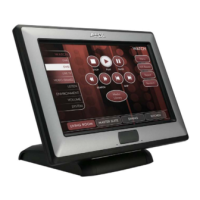CV10 Touch Panel Accessories
10
10" Modero Touch Panels
Wiring the NXA-AVB/ETHERNET for Unbalanced Audio
Most domestic audio equipment has unbalanced audio inputs and outputs. This means that the audio output
(left, right, or mono) appears on a single wire, and is referenced to "0 V" or "Ground". Typical connectors used
are RCA "phono" connectors, DIN plugs/sockets, and 0.25" (6.3mm) or 3.5mm jack plugs/sockets.
Unbalanced audio is adequate for most domestic environments and for line-level signals in a typical broadcast
studio. Problems may occur if the signals are carried over long distances, especially if the source and
destination have separate main supplies. Use the following wiring drawing (FIG. 8) to configure an
unbalanced audio connection.
When using unbalanced audio for the AUDIO IN connector (FIG. 8), the "-" and the "GND" terminals should
be connected together and then connected to the GND of the unbalance audio signal. When connecting to an
unbalanced audio input from the MIC OUT connector (FIG. 8), wire the "+" terminal to the signal input, and
the "GND" terminal to the signal ground.
Wiring the NXA-AVB/ETHERNET for Balanced Audio
Professional audio equipment will often use balanced audio inputs and outputs, usually on 3-pin "XLR"
connectors. A balanced audio signal consists of a pair of wires carrying the audio signal in anti-phase with
each other (if one wire carries a positive voltage, the other carries an equal and opposite negative voltage).
The advantage of balanced audio over unbalanced audio is its ability to reject external interference added as
the signal is carried over the wire. The receiving equipment takes the voltage difference between the two wires
as the input signal. Interference will usually get added to both wires equally, and so gets cancelled by the
receiving equipment.
The 3 wires used in a typical XLR lead are often referred to as Ground, Live (Hot) and Return (Cold). "Live"
and "Return" carry the "in-phase" and "out-of-phase" versions of the audio respectively. The pins of the XLR
plug/socket are as follows:
When connecting the MIC OUT connector to a balanced audio input (FIG. 9), use all three audio terminals (+,
-, and GND), then connect the "+" terminal to the "live" signal, the "-" terminal to the "return" signal, and the
"GND" terminal to the ground signal.
•PWR: 2-pin mini-Phoenix connector that connects to a 12 VDC-compliant power
supply.
This port can be used to provide power to a Modero panel by sending it
through the NXA-AVB/ETHERNET (rear power connector through to the front
power connector).
FIG. 8
Wiring the rear AUDIO IN and MIC OUT for use with Unbalanced Audio
• X = Ground
• L = Live (Hot)
• R = Return (Cold)
Unbalanced IN
GND
IN-
IN+
GND
IN-
IN+
Left Channel
Right Channel
(Jumper IN- to GND)
Unbalanced OUT
GND
OUT-
OUT+
Microphone
Unbalanced IN
(Jumper IN- to GND)
AUDIO IN
MIC OUT

